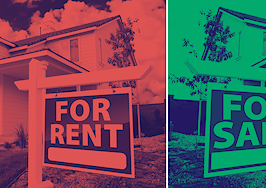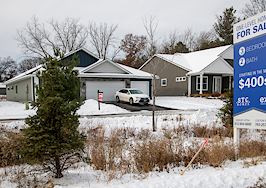In these times, double down — on your skills, on your knowledge, on you. Join us Aug. 8-10 at Inman Connect Las Vegas to lean into the shift and learn from the best. Get your ticket now for the best price.
Although it has barely begun, the spring homebuying season has already been cast as the ultimate game of Catch-22.
Home prices are beginning to loosen, despite fluctuating mortgage rates primed to offset the savings. A robust jobs market and coinciding wage growth have placed Americans in the best financial position to purchase a home — yet that same market has made it difficult for the Federal Reserve to slow inflation. Those thorns, and other financial burdens, have deeply embedded themselves in everyone’s budgets.
Current market conditions have also complicated the generational flow of housing stock. Baby boomers are pushing off retirement and staying in their homes longer as rising rates and prices make it difficult to leave a paid-off home for sunnier shores. The ramifications of those decisions have rippled down to millennials and the oldest Gen-Zers, who are struggling to find their footing in inventory-starved markets.
Mind the gap: How mortgage rates will impact millennials, baby boomers
“I think the current demographics in the U.S. are a tremendous tailwind to housing, but at the same time, they are inherently creating a problem,” Realtor.com Senior Economist George Ratiu said. “In essence because of this tailwind, given the shortage of inventory, we’re obviously running into a problem with affordability.”

George Ratiu
Ratiu said there are 44 million Americans who have hit their prime homebuying age, which is between the ages of 26 and 35. Despite common stereotypes about millennials and Gen-Zers valuing avocado toast and lattes over homeownership, Ratiu said multiple surveys show these generations want to purchase homes.
“We heard the mantra ‘Well, young people no longer want to buy homes because of the housing crash.’ That myth has been busted,” he said. “That demographic tailwind [of millennials and Gen-Zers] is going to sustain real estate and housing markets for quite a few more years.”
However, Ratiu and Windermere Chief Economist Matthew Gardner said low inventory and worsening affordability will make it more difficult than ever for millennials to break through, and they’ll be hard-pressed to find windows of opportunity in the existing-home market as baby boomers find little incentive to move and lose access to historically-low mortgage rates.
“We have a lot of households that have locked in mortgage rates over the last couple of years at around 3 percent,” Gardner said of the choice baby boomers must make. “Why would you sell into an environment where mortgage rates have more than doubled? You would lose a never-to-be-seen-again mortgage rate.”

Danielle Hale
Although current rates are nowhere near the peak, Realtor.com Chief Economist Danielle Hale said the jump in rates that Gardner described makes a huge difference in monthly mortgage payments — an added cost that would make anyone, regardless of age, think twice.
“The gap between the rates that existing homeowners have on their current mortgage and the rate they would face if taking on a new mortgage will be bigger this spring than any time in recent history,” she said. “Most homeowners with a mortgage have a rate under 4 percent whereas the rate homebuyers would pay to mortgage a home with a 30-year fixed rate loan is creeping up toward 7 percent.”
“That creates a monthly payment gap of roughly $190 per month for every $100,000 borrowed,” she added. “The calculus of deciding whether to sell or stay has gotten more complicated as mortgage rates have surged.”
The impact of rising rates has pummeled the existing-home market, with existing-home sales in January declining 0.7 percent month over month and 36.9 percent year over year to a seasonally adjusted annual rate of 4.00 million. During the same time period, total housing inventory increased 2.1 percent month over month and 15.3 percent year over year to 980,000 units. Despite that jump, the market is still far from being balanced with a 2.9-month supply at the current sales pace.
“People have also used the narrative that baby boomers are retiring and they’re gonna move into retirement homes or downsize therefore freeing up a lot of existing homes. I think that’s another myth to be very honest with you,” Ratiu said. “There are a lot of people in that age demographic who’ve said, ‘I don’t really have an interest in downsizing because the home I’m in is my dream home. It’s the home where my children and grandchildren are now gathering for holidays or special events. There’s very little incentive to necessarily sell.”
The new-home market won’t save homebuyers

Orphe Divounguy
With more homeowners sitting on existing-home inventory, millennials may be tempted to place their eggs in the new-home market. Zillow Senior Economist Orphe Divounguy said that could be a smart move for some buyers as homebuilders offer more incentives to get rid of inventory.
“I think a lot of people are hopeful that new homes will come to fill in the gaps because inventory is so low and the existing homeowners are not listing their homes,” he said. “You’re going to get more builders that are ready and willing to sell, and they’ll be willing to give buyers many incentives like rate buydowns and different types of rebates.”
Although buyers will benefit from rebates and other deals, Gardner said the new-home market is still chronically undersupplied, and the impact of increased construction costs, long zoning and permitting timelines and a lack of available land in denser, coastal markets will hit buyers in their pockets, with the median sales price for new homes reaching $427,500 in February — 19 percent higher than the median cost for existing homes ($359,000).
“Yes, lumber prices have come down. That’s a good thing,” he said while noting the cost of framing lumber has dropped 72 percent year over year with the price per-thousand-board-feet dropping from $1,411 to $369. “But [the cost of] building is still going to be that much higher from a builder’s perspective.”
“[Exterior] paint is up 45 percent year over year. Why? Because outside exterior paint is oil-based. PVC pipe which again, is based on the price of oil, is still very expensive,” he added. “It’s just gonna be very hard for first-time buyers going forward.”
The silver lining in generational buying and selling trends
Despite the challenges of fluctuating mortgage rates, worsening affordability and low inventory, TKI co-founder and CEO Thomas Gamble told Inman his company’s latest quarterly analytics report shows a silver lining.
“We really just had a completely out-of-this-world experience over the last couple of years where if it has a driveway and a door, it’s gonna sell over ask with multiple buyers,” he said. “Obviously, we’re not in that market anymore and that’s maybe knocking out some of the opportunistic sellers.”
“But just because those opportunities may have dropped down or changed a little bit, that’s not really the dominant reason people move,” he added. “They move or list their home, you know, based on various things like being close to family or other socioeconomic trends that are happening either immediately with themselves.”
With that in mind, Gamble predicts empty nesters — homeowners between 45-64 with no children at home — are expected to make up 10.2 percent of all listings that come to the market by February 2024. Retirees (those 65 and older) are expected to be 7.5 percent of the selling community during the same time period. That may not constitute a silver tsunami, Gamble said, but it shows there’s still plenty of opportunity in a down market.

Thomas Gamble
Gamble said his analytics model, which covers 128 million households and more than 300 data points, shows older homesellers make waves in tried-and-true retiree markets in Florida and Arizona, including Punta Gorda, Naples, Sarasota Beach and Lake Havasu over the next 12 months. Hot Springs, Arkansas, and Hattiesburg, Mississippi, snuck in as little-talked-about favorites for empty nesters and retirees looking for an ultra-affordable lifestyle.
“With a projected slowdown in 2023 sales, it is critically important to understand the lifestyle triggers that will impact listings,” he said. “Older families and Americans should not be forgotten. They make up a sizeable pool of potential sellers and should be marketed to.”
When it comes to millennial homesellers, Gamble said young households will be more active in the market than their single counterparts.
School-aged families with children between the ages of seven and 17 will comprise 23.5 percent of listings over the next 12 months. Families with children between the ages of 18 and 24 are expected to come in second place with 15.8 percent of listings. Singles and couples under 35 with no children will have a harder time breaking through comprising 8.7 percent and 5.4 percent of listings, respectively. Young families with children under the age of six are expected to run in the middle of the pack with 6.4 percent of listings.
Although this data at first may seem discouraging for millennial homebuyers, Gamble said it actually reveals plenty of current and future opportunities in affordable markets across the South and Midwest — the areas with the most active millennial homesellers. He said millennials, especially singles, can use their flexibility to get their foot in the door, even if it means a move to places like Kansas, Oklahoma, Louisiana, Minnesota or South Dakota.
“I think the workplace has forever changed what we call the traditional work environment, and I think there are a lot of firms that have increased their flexibility and it allows you to really work from anywhere,” he said. “Your typical millennial or single buyer, regardless of age, is always more flexible with taking risks and making those moves.”
Ratiu echoed Gamble and said millennials are finding their footing in places that were once written off as fly-over markets.
“Amazon opened their second [HQ] in northern Virginia. Apple built a second HQ in Raleigh, North Carolina. Seeing trends like that is actually another bit of good news because it gives workers a more balanced financial ability to make a living and afford a home,” he said. “There are also places like Cincinnati, Cleveland and Columbus that were written off but have seen a resurgence because young people are moving there to take advantage of stronger job opportunities with companies like Intel.”
Getting back to normal
With all this said, Divounguy said there’s no guarantee on how things will play out for millennials, baby boomers or consumers of any generation. A one percentage point increase in mortgage rates could bring sales down between 5 and 10 percent — a reality that’s already played out earlier this year.

Matthew Gardner
“The research shows a one percentage point increase in mortgage rates will lower housing sales by roughly 5 to 10 percent,” he said. “Mortgage rates had fallen to about [6.15] percent at some point in January, and now they’re back to 6.8 percent. So we’re having this almost one full percentage point increase.”
All five experts said patience will be the key to making it through the spring as the market continues to move closer to historical norms.
“We are not in any housing recession,” Gardner said. “The phrase I’m using is housing reversion. Home prices are reverting back to the mean. They’re reverting back to that long-term trend of growth because we got way out over our skis in 2020, 2021 and part of 2022.”
“All we’re doing now is we’re pulling back to that long-term trend,” he added.













